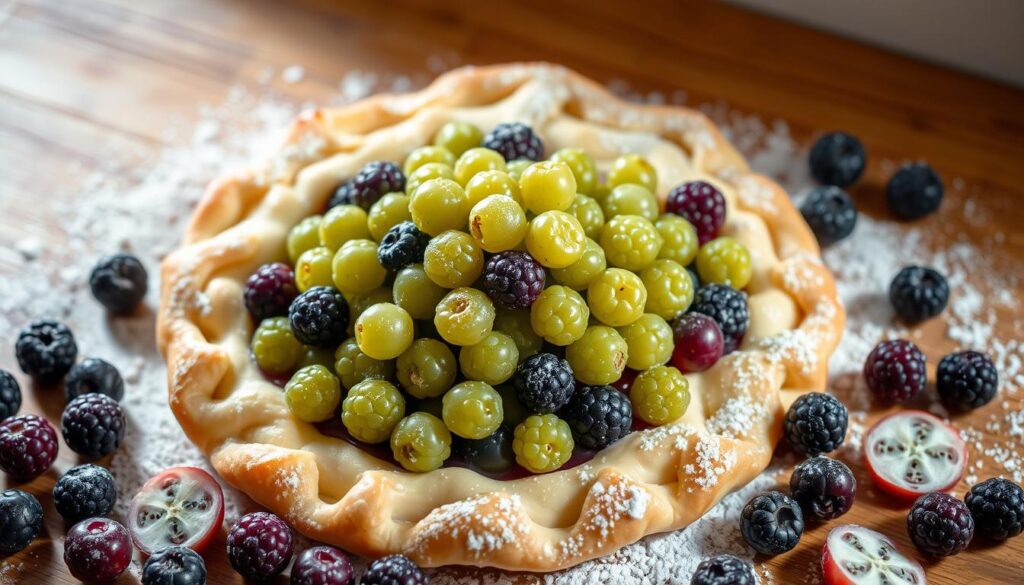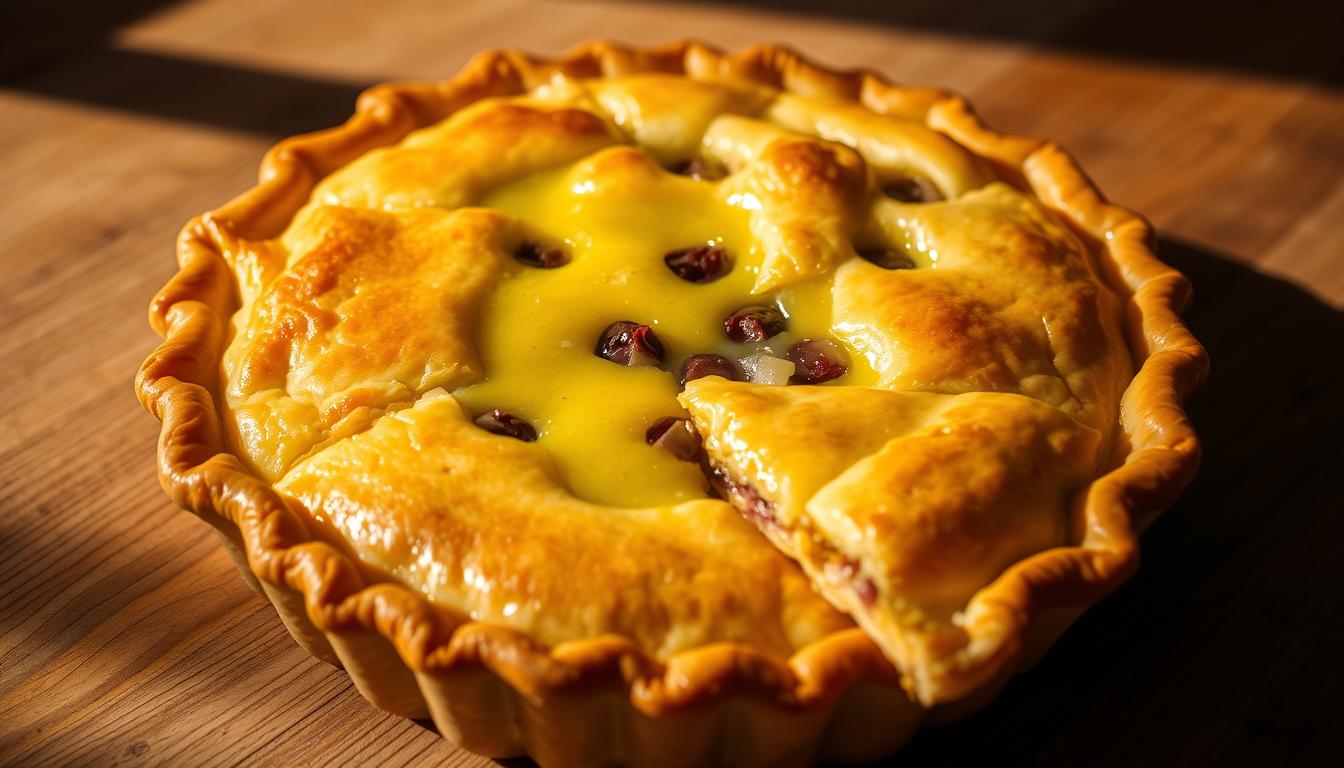Ultimate Gooseberry Pie: A Classic Recipe Made Easy
Are you ready to bake a gooseberry pie that perfectly balances sweet and tart flavors? Imagine a fruity filling wrapped in a tender, flaky crust—pure comfort dessert. This gooseberry pie recipe shows you how to get that juicy, tangy filling just right — just like a traditional British gooseberry pie.
You’ll learn how to transform gooseberries into a delicious pie filling that’s both juicy and full of zingy flavor. With this recipe, you’ll understand what makes this dessert special and how to master it, even if you’re new to baking with these unique berries or exploring classic gooseberry recipes.
Table of Contents
The Charm of Gooseberry Pie
The charm of a gooseberry pie lies in its perfect balance of sweet and tart flavors that make it a timeless favorite among gooseberry recipes. This dessert has been a favorite for many, thanks to its unique taste and nostalgic value.
What Makes Gooseberry Pie Special
Gooseberry pie is special because of its distinctive sweet-tart flavor profile. The natural tartness of gooseberries creates a refreshing contrast to the sweetened filling and buttery crust, making it a true British gooseberry pie classic. This balance is what sets gooseberry pie apart from other fruit pies.
As noted by food enthusiasts, “The unique flavor of gooseberries, combined with the simplicity of a traditional pie crust, makes for a truly unforgettable dessert experience.” –
A Perfect Balance of Sweet and Tart
A great gooseberry pie is equal parts sweet and sour. The buttery taste of the crust and the sweetness of the filling help balance the unique sour flavor of the gooseberries. This balance is crucial to creating a pie that is both tangy and sweet— one reason this gooseberry pie recipe stands out from other fruit desserts.
| Characteristics | Description |
|---|---|
| Flavor Profile | Sweet and Tart |
| Filling | Vibrant, translucent green |
| Crust | Buttery and flaky |
All About Gooseberries for Baking
When it comes to baking a gooseberry pie, the type and quality of gooseberries you use can make all the difference. Gooseberries are a versatile fruit that can range from very tart to semi-sweet depending on their ripeness — a key factor in most gooseberry recipes, especially gooseberry pie.
What Do Gooseberries Taste Like?
Gooseberries have a unique flavor profile that changes as they ripen. Green gooseberries are typically tart and tangy, while ripe gooseberries turn golden or purple and become sweeter, similar to grapes. The taste of gooseberries can significantly impact the flavor of your pie.
Where to Find Gooseberries for Your Pie
You can find gooseberries at farmers’ markets, specialty stores, or online retailers, especially during their peak season. When shopping for gooseberries, look for berries that are firm and have a vibrant color. Understanding the seasonal availability of gooseberries will help you identify quality berries.

Fresh vs. Frozen vs. Canned Gooseberries
The choice between fresh, frozen, or canned gooseberries depends on availability and the desired texture for your pie. Fresh gooseberries offer the best flavor, but frozen or canned can be convenient alternatives. Here’s a comparison:
| Type | Flavor | Texture | Convenience |
|---|---|---|---|
| Fresh | Best flavor | Firm | Moderate |
| Frozen | Good flavor | Soft | High |
| Canned | Less tart | Soft | High |
Using the right type of gooseberry for your pie can help achieve a perfect balance of sweet and tart flavors, making your dessert a true delight.
Ingredients for the Perfect Gooseberry Pie Recipe
The key to a perfect gooseberry pie lies in its ingredients. To make a delicious pie, you’ll need to carefully select the components for both the pie crust and the gooseberry filling. This ingredient combination creates a traditional gooseberry dessert that feels both nostalgic and comforting.
For the Pie Crust
The pie crust is a crucial element of the gooseberry pie. You’ll need flour, frozen butter, ice water, white vinegar, salt, and a bit of sugar. Using cold butter and ice water is essential for creating a flaky crust.
For the Gooseberry Filling
For the filling, you’ll need gooseberries (canned or fresh, drained), apple (peeled and chopped), honey, salt, sugar, elderflower cordial, dry tapioca, and a pinch of ground nutmeg. The tapioca acts as a thickener, ensuring the filling isn’t too runny.
| Ingredient | Quantity | Purpose |
|---|---|---|
| Flour | 2 cups | Structure |
| Butter | 1 cup | Flavor and flakiness |
| Gooseberries | 2 cups | Main filling ingredient |
| Tapioca | 2 tbsp | Thickening agent |
Essential Equipment for Baking a British Gooseberry Pie
To prepare the pie, you’ll need a pie plate, rolling pin, pastry cutter, and mixing bowls. Having the right equipment will make the process smoother and more enjoyable.

Step-by-Step Gooseberry Pie Recipe Instructions
Creating the perfect gooseberry pie involves several key steps that we’ll walk you through to ensure your gooseberry pie recipe turns out amazing every time. From preparing the gooseberries to baking the pie, our guide ensures you achieve a deliciously balanced dessert.
Follow these simple directions to make your own gooseberry pie recipe at home — it’s easier than most traditional gooseberry desserts.
Preparing the Gooseberries
Start by topping and tailing the gooseberries, which involves pinching off the little stem end and blossom end. This simple step readies the gooseberries for your pie filling. You can also prepare other ingredients like apples by peeling, coring, and slicing them into thin pieces.
Making the Gooseberry Filling
To create the perfect gooseberry filling, combine the prepared gooseberries with sugar, tapioca, and other necessary ingredients in a bowl. The mixture should achieve an ideal balance of sweetness and thickness. This step is crucial for the overall flavor and texture of your gooseberry pie recipe, ensuring that signature balance of sweetness and tang.
Preparing the Pie Crust
Making a flaky pie crust from scratch requires keeping your ingredients cold and handling the dough minimally. Roll out the bottom crust for the pie and fit it into a 9-inch pie plate. Ensure the crust is evenly spread and properly aligned within the plate.
Assembling and Baking the Pie
To assemble the pie, fill the pie crust with the gooseberry filling and top it with another layer of crust or a decorative lattice top. Preheat your oven to 450°F (230°C). Bake the pie for the recommended time, checking for visual cues like a golden-brown crust to determine when it’s perfectly done.
Tips for Baking a Perfect Traditional Gooseberry Dessert
With these professional tips, you’ll be well on your way to baking a perfect gooseberry pie. To start, it’s essential to understand the key elements that make a gooseberry pie exceptional.
Getting the Right Filling Consistency
Achieving the perfect consistency in your gooseberry filling is crucial. Using tapioca as a thickener can help. Make sure to adjust the amount according to the tartness of your gooseberries.
Achieving the Perfect Buttery Crust
For an authentic British gooseberry pie, keep your butter cold and the crust flaky. Don’t skip chilling the dough, as it makes the crust easier to work with and bakes up beautifully.
Balancing Sweetness and Tartness
Gooseberries can vary in tartness, so it’s crucial to taste your filling as you go and adjust the sugar accordingly. This ensures your pie is perfectly balanced.
| Tip | Benefit |
|---|---|
| Keep butter cold | Flaky crust |
| Use tapioca as thickener | Perfect filling consistency |
| Taste filling as you go | Balanced sweetness and tartness |
Variations and Substitutions
To make your gooseberry pie truly unique, try experimenting with ideas inspired by other gooseberry recipes and flavor pairings. This allows you to tailor the recipe to your taste preferences and dietary needs.
Alternative Sweeteners
You can substitute brown sugar for all or part of the white sugar in the filling. Brown sugar adds a rich, molasses flavor that complements the tartness of the gooseberries. Other alternatives like honey or maple syrup can also be used, but be aware that they will change the flavor profile of your pie.
Adding Complementary Flavors
Enhance your gooseberry pie by adding complementary flavors such as cinnamon, nutmeg, or lemon zest. These ingredients can add depth and complexity to the filling. You can also experiment with different extracts like vanilla to create a unique taste experience.
Crust Alternatives
gluten-free crust or a vegan alternative to traditional butter and eggs. You can also make a gooseberry pie recipe variation like a crumble pie with streusel topping or a custard-style British gooseberry pie for a different texture.
Serving and Storing Your Homemade Gooseberry Pie
Serving and storing your gooseberry pie properly can enhance its flavor and texture. You can serve it warm with a scoop of vanilla ice cream, at room temperature, or chilled for a different taste experience.
For storage, if you plan to devour your pie within 1-2 days, covering it with cling film and storing it on the counter is fine. For longer storage, up to 4 days, it’s best to store it in the fridge, covered. You can also freeze it for later use — it’s a great way to enjoy a British gooseberry pie anytime you crave that tart-sweet goodness.
Tips: To reheat, place a slice in the oven at a low heat for a few minutes until warmed through. Consider serving with whipped cream or crème fraîche for added flavor.
FAQ
What is the best way to prevent the crust from becoming soggy?
Can I use frozen gooseberries instead of fresh ones?
How do I know when the tart is done baking?
Can I substitute sugar with other sweeteners like honey or maple syrup?
How should I store leftover gooseberry tart?
What can I serve with gooseberry tart?
Bake It. Love It. Tell Us About It.
There are no reviews yet. Be the first one to write one.

